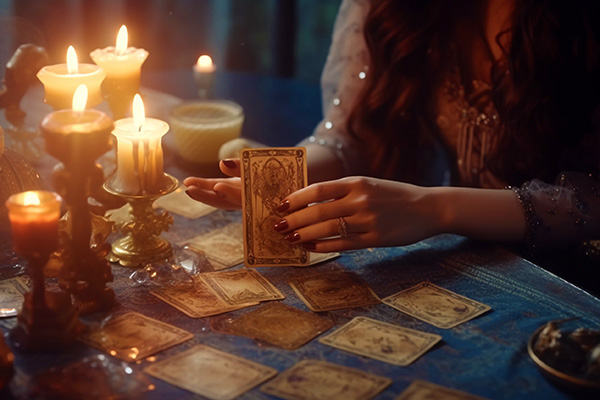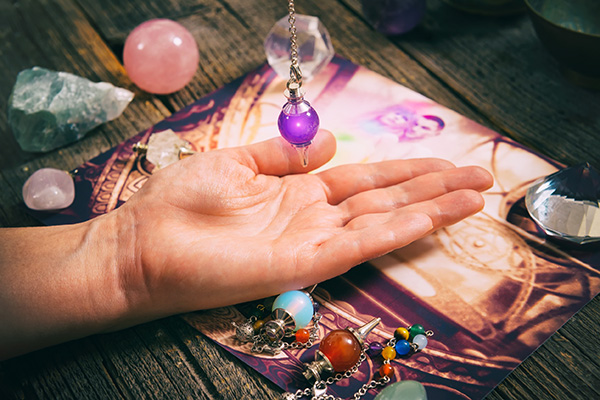Psychic Readings
Always Keep An Open Mind In Psychic Readings
 In high school, I predicted that a friend of mine would lose something valuable and then have a car accident shortly thereafter.
In high school, I predicted that a friend of mine would lose something valuable and then have a car accident shortly thereafter.
I also warned him that the loss of something valuable would be an omen: a sign from the universe for him to be more careful and responsible.
He looked at me like I was crazy.
A few months later he lost his wallet because he had been careless. He later told me it reminded him of what I had said and it shook him up enough to start being more careful in his daily life. He even stopped his bad habit of never using his seat belt when driving.
Good thing he did. A few months later, he drove his car off a cliff! The police officer told him that he would have been killed if he had not been wearing his seat belt.
He brought up the story at our ten-year high school reunion and praised me as the person who saved his life. Of course, I did not mention the eye-rolling and “you’re crazy” look he gave me at the time. Besides, saying “I told you so” is not very dignified.
Not much has changed since high school. As a professional psychic, I still have to tell my clients things that makes them doubt our connection or my ability, and sometimes even my sanity! You learn to suck it up and deal with the raised eyebrows and side-eyes.
I understand how it feels for them, because I have had to keep an open mind as a psychic client, too. Many years ago, a medium told me that I would also work as a psychic one day. I thought this was really strange because I had been in the performing arts most of my life, and in my mind there was no way she could be right. But here I am today. Even psychics don’t always know where life is taking them.
Tarot Forecast October 2024: Ten Of Wands
 The card this month is the Ten of Wands, which predicts the potential for life’s challenges to feel overwhelming in the weeks ahead, but this will also offer us the opportunity for personal growth through perseverance.
The card this month is the Ten of Wands, which predicts the potential for life’s challenges to feel overwhelming in the weeks ahead, but this will also offer us the opportunity for personal growth through perseverance.
When we push through difficulties, we not only build strength, but also shape our perception of success. It’s important to remember that how we view our challenges often determines whether we see them as victories or defeats.
The burdens that life places on us make us grow and know that we are resilient when things don’t go our way. Knowing that even when we see situations not working in our favor, if we see value and learning in it, we dare to stand up for ourselves and go for it anyway.
This month it may feel like we’re juggling a lot at once, but in these challenges lies the opportunity to gain wisdom and clarity. It may feel heavy, as if we have too many responsibilities or carry an emotional burden that’s hard to release.
The central image depicted on the Ten of Wands cards is a figure burdened by having to carry ten heavy wands, symbolizing an overwhelming load or heavy burden. The figure is struggling under the weight, illustrating the concept of carrying too much responsibility or facing numerous challenges. It emphasizes the physical and emotional strain that can result from over-commitment or excessive obligations.
The figure is also walking along a narrow path or road, suggesting a journey or direction. The path indicates that the stresses are part of a larger journey or goal, implying that the challenges are necessary to achieve something significant.
The Timeless Appeal Of Tarot Divination
 I have yet to meet a spiritually-minded person who does not like the Tarot, or at least is not a little intrigued by this famous deck of cards.
I have yet to meet a spiritually-minded person who does not like the Tarot, or at least is not a little intrigued by this famous deck of cards.
The Tarot is arguably the world’s most popular and widely used divination tool, renowned for its rich symbolism and the depth of insight it offers. As an esoteric tradition dating back centuries, the Tarot has evolved into a diverse, sophisticated system of divination used by people from all walks of life to explore the mysteries of the mind, spirit, and the future.
Unlike some other forms of divination that require specialized knowledge or tools, the Tarot is accessible to both beginners and seasoned practitioners, offering a unique blend of art, intuition, mysticism, and storytelling. Its versatility allows it to address a wide range of questions, from personal and spiritual dilemmas to broader societal issues, making it a go-to resource for those seeking guidance, clarity, and self-discovery in an ever-changing world.
Each of the 78 cards in a Tarot deck is loaded with symbolic imagery and archetypal meanings that can be interpreted on multiple levels, from the deeply psychological to the spiritual and mystical. This layered symbolism allows diviners to explore personal dilemmas, spiritual growth, and the mysteries of life.
Unlike other divination tools that may rely on more rigid systems, Tarot offers a fluid framework that adapts to the reader’s intuition, personal beliefs, and level of psychic ability, making it accessible to people of diverse backgrounds and spiritual practices.
Learning To Trust Your Intuition
 We are all born with an innate intuitive ability. However, many of us tend to shut down this innate aspect of our inner being at a young age.
We are all born with an innate intuitive ability. However, many of us tend to shut down this innate aspect of our inner being at a young age.
This can happen for a variety of reasons, but fear is often a major factor. Over time, many of us learn to view our intuition as our mind “playing tricks” or something to be wary of, or even as a source of discomfort that is just all in our imagination.
This misconception is unfortunate because intuition is not something to be feared or dismissed; rather, it is an integral part of our being that provides valuable insight and guidance.
Intuition is a fundamental part of living a full and complete life because it is a key part of our spiritual inner guidance. It cannot be lost or taken away. You are always in control of it and can choose to connect with it at any time.
The key to accessing and making the most of this inner wisdom is learning to trust its messages. But this can be challenging, especially when those messages are unclear or confusing. So, how do you cultivate greater trust in your intuition?
The first step in building trust with your intuition is to acknowledge and track the information it provides. Keep a journal or note-taking app handy and write down any intuitive insights you receive about your plans, goals, people, or situations. By recording these insights, you create a space for learning to understand how your intuition works and for validating your impressions over time.
The Principles Of Ethical Psychic Reading
 When I first began working as a professional psychic, both my guides and human mentors impressed upon me the importance of remaining ethical in my practice.
When I first began working as a professional psychic, both my guides and human mentors impressed upon me the importance of remaining ethical in my practice.
Ethical psychic reading is crucial because it not only maintains the integrity of our field of work, but it is also builds trust with the people who need our support and guidance the most.
People don’t contact a psychic when life is good. Our clients only seek psychic guidance when they are struggling, confused, or facing important life decisions, making them vulnerable and susceptible to influence and manipulation.
Ethical psychic readers respect the mental, emotional, and spiritual well-being of their clients and provide honest, compassionate, and sincere guidance. Ethical psychic practices also ensure that the psychic reader does not make false claims, guarantees, or predictions that could mislead or cause harm.
Adherence to ethical standards and spiritual values protects both clients and readers by fostering a positive and supportive environment in which people can explore their concerns and seek clarity without fear of deception or harm.
I vividly remember a young woman who came to me many years ago desperate to become a mother. She had no children at the time, and she especially wanted a daughter. She told me that if I could see a baby girl in her future, she would be more than happy to pay me extra money for my services.
The Karmic Lessons Of Our Past Lives
 Each lifetime offers us karmic lessons inherited from our past lives, often presenting what we perceive as hardship or misfortune, but are actually opportunities for soul growth.
Each lifetime offers us karmic lessons inherited from our past lives, often presenting what we perceive as hardship or misfortune, but are actually opportunities for soul growth.
These soul lessons are “karmic” because they were created or caused by our free will choices, decisions and actions in previous lives. They resurface in our current lifetime to be resolved, redeemed, released, and healed.
In ancient Sanskrit, karma (कर्म) literally means “action” or “deed.” It is derived from the root word kri, which means “to do” or “to act.”
According to many spiritual and philosophical tradition the essence of karma is that every action (physical, verbal, mental, spiritual) has consequences that reverberate through time and space and affect our present and future circumstances. Our actions in every lifetime create karmic ripples that influence the fabric of our existence, shaping our future life experiences and soul growth journey.
Karmic imprints are the energetic residues of our past actions, thoughts, and emotions that carry over from previous lives into our present existence. These imprints often manifest as recurring patterns, challenges, or opportunities in our current lifetime. The core principle is that our actions, thoughts, and emotions create a cause-and-effect relationship that extends beyond a single lifetime. Positive actions result in positive consequences, while negative actions result in negative consequences.
Karmic imprints are stored in the etheric energy field known as the Akashic Records, or Universal Consciousness, that records all human experience. When a soul reincarnates, it brings these imprints with it, influencing its experiences and choices in the current life.
The Mystical Art Of Pendulum Divination
 Divination, the ancient spiritual practice of seeking knowledge of the future and the unknown through supernatural means, has been an integral part of human history for millennia.
Divination, the ancient spiritual practice of seeking knowledge of the future and the unknown through supernatural means, has been an integral part of human history for millennia.
From the casting of lots practiced in various forms by indigenous and aboriginal cultures around the world using bones, stones, shells, and other natural objects, to the Tarot of 15th century Europe, to today’s cyber-divination and AI-powered fortune-telling, various tools have been used to connect with the spirit realm and uncover one’s destiny.
Among these tools, one of the most accessible and easy-to-use traditional methods of divination is the pendulum. The best part is that this simple yet powerful tool is already within reach, tucked away in your jewelry box or craft kit.
A pendulum is simply a weighted object attached to a chain, string, or cord. It can be as elaborate or as simple as you like – a crystal dangling from a silver chain, a beloved piece of jewelry, or even a simple stone tied to a piece of string. The key is to choose an object with some weight to it so that it will swing freely when held aloft.
Pendulum divination is a form of dowsing, a practice that dates back thousands of years and has been used to locate water, minerals, and even lost objects. Dowsing works by tapping into the subconscious mind, which is connected to universal consciousness and the spirit realm. When using a pendulum for divination, you are essentially asking your subconscious to communicate with you through the movements of the pendulum.